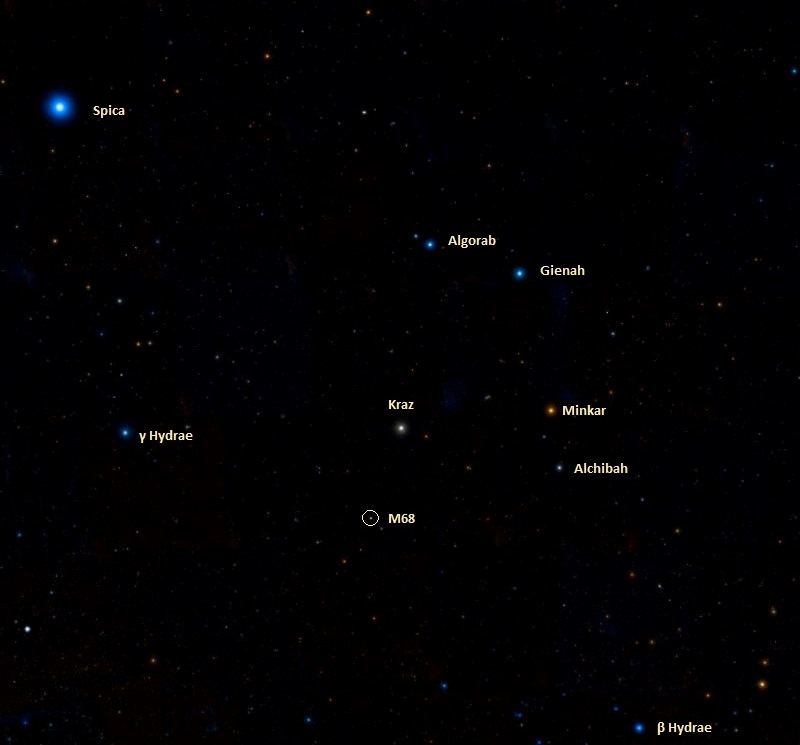Welcome back to Messier Monday! Today, we continue in our tribute to our dear friend, Tammy Plotner, by looking at the globular cluster known as Messier 68.
In the 18th century, while searching the night sky for comets, French astronomer Charles Messier kept noting the presence of fixed, diffuse objects he initially mistook for comets. In time, he would come to compile a list of approximately 100 of these objects, hoping to prevent other astronomers from making the same mistake. This list – known as the Messier Catalog – would go on to become one of the most influential catalogs of Deep Sky Objects.
One of these objects is the globular cluster known as Messier 68. Located roughly 33,000 light-years away in the Constellation of Hydra, this cluster is orbiting through the Milky. In addition to being one of the most metal-poor globular clusters, it may be undergoing core collapse, and is believed to have been acquired from a satellite galaxy that merged with the Milky Way in the past.
Description:
At a distance of approximately 33,000 light-years, the M68 globular cluster contains at least 2,000 stars, including 250 giants and 42 variables - one of which is actually a foreground star and not a true member. Spanning 106 light years in diameter and coming towards us at a speed of 112 kilometers per second, about 250 giant stars are happily perking away - enjoying their chemically abundant status. As Jae-Woo Lee (et al), indicated in a
2005 study
:
[caption id="attachment_139133" align="aligncenter" width="565"]
Image of Messier 68, taken by the NASA/ESA Hubble Space Telescope oCredit: Hubble/NASA/ESA
[/caption]
One of the most unusual features of Messier 68 is its position in the grand scheme of things - opposite our galactic center. We know that globular clusters lay almost exclusively within the galactic halo, so what could cause this? As Yoshiaki Sofue of the University of Tokoyo's Department of Astronomy explained in a
2008 study
:
And that fact is carried out by further studies. As Roberto Capuzzo Dolcetta (et al) demonstrated in a study:
[caption id="attachment_139132" align="aligncenter" width="580"]
Messier 68 globular cluster by Hubble Space Telescope; 3.32? view. Credit: NASA & ESA (Hubble Space Telescope)
[/caption]
Is it true that Messier 68 may indeed by a "left over" from another galaxy? Yes, indeed. As M. Catelan argued in a
2005 study
:
History of Observation:
M68 was discovered by Charles Messier on April 9, 1780 who described it as; "Nebula without stars below Corvus and Hydra; it is very faint, very difficult to see with the refractors; near it is star of sixth magnitude". The first resolution of the individual stars was, of course, attributed to Sir William Herschel. As he wrote in his notes at the time:
Thanks to a rather strange error on Admiral Smyth's part, for many years it was believed to be the discovery of Pierre Mechain. As Smyth wrote in his notes:
This error took nearly a century to correct! Don't take a century to view this lovely globular cluster yourself..
.
[caption id="attachment_139134" align="aligncenter" width="580"]
The location of Messier 68 in the Hydra constellation. Credit: IAU and Sky & Telescope magazine (Roger Sinnott & Rick Fienberg)
[/caption]
Locating Messier 68:
The brighter stars of the northern winter season make finding this small globular cluster quite easy for both binoculars and telescopes - begin first by identifying the lopsided rectangle of the constellation of Corvus and focus your attention on its southeastern most star - Beta. Our target is located about three finger-widths southeast of Beta Corvi and just a breath northeast of the double star A8612.
It will show as a faint, round glow in binoculars, and small telescopes will perceive individual members. Large telescopes will fully resolve this small globular to the core! Messier Object 68 is well suited to any sky conditions when the stars of
Corvus
are visible.
And here are the quick facts on this Messier Object to help you get started:
- Object Name
-
Messier 68
- Alternative Designations
-
M68, NGC 4590
- Object Type
-
Class X Globular Cluster
- Constellation
-
Hydra
- Right Ascension
-
12 : 39.5 (h:m)
- Declination
-
-26 : 45 (deg:m)
- Distance
-
33.3 (kly)
- Visual Brightness
-
7.8 (mag)
- Apparent Dimension
-
11.0 (arc min)
We have written many interesting articles about Messier Objects here at Universe Today. Here's Tammy Plotner's
Introduction to the Messier Objects
,
M1 – The Crab Nebula
, and David Dickison's articles on the
2013
and
2014
Messier Marathons.
Be to sure to check out our complete
Messier Catalog
. And for more information, check out the
SEDS Messier Database
.
Sources:
- Messier Objects - Messier 68
- *NASA - Messier 68*
- Wikipedia - Messier 68
 Universe Today
Universe Today
